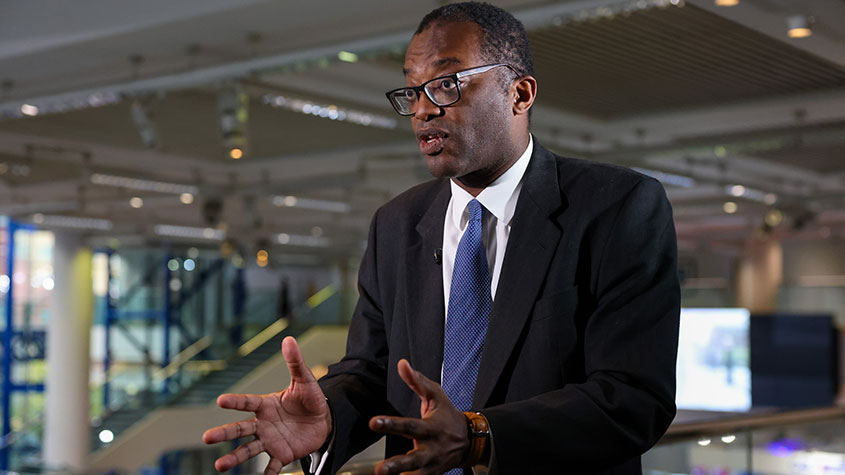Stop building on England’s green and pleasant land
Theresa May recently announced a major overhaul to the National Planning Policy Framework to “deliver the homes the country needs”. If only it were that simple, says Emily Hohler.


On 5 March, Theresa May announced a major overhaul to theNational Planning Policy Framework to "deliver the homes the country needs". If only it were that simple, says Emily Hohler.
The housing crisis is a politically toxic issue and poses an existential threat to the Tories traditionally the party of property ownership. Runaway house-price growth over decades has left home ownership beyond the reach of many, particularly in the southeast. Houses in the UK now cost almost eight times average earnings. In London, the figure rises to 14.5. These are the worst ratios of any developed country, and housing costs are a major source of inequality. Prices are high in part because property has become a speculative market, especially in London, fuelled by private capital (often foreign), easy mortgage credit and subsidies such as the Help to Buy scheme.
For Theresa May, however, the "root cause is simple": not enough homes in the right places. The 2016/17 financial year saw a 15% increase in new-builds, to 217,350, but this falls short of the government's target of 300,000 annually by 2025. The draft National Planning Policy Framework (NPPF), which is due to become official policy after a consultation period ending just after MoneyWeek went to press, sends out a clear message that the government intends to accelerate housebuilding.
MoneyWeek
Subscribe to MoneyWeek today and get your first six magazine issues absolutely FREE

Sign up to Money Morning
Don't miss the latest investment and personal finances news, market analysis, plus money-saving tips with our free twice-daily newsletter
Don't miss the latest investment and personal finances news, market analysis, plus money-saving tips with our free twice-daily newsletter
A savagely centralised regime
The NPPF sets out the government's planning policies for England and how they should be applied. New houses cannot be built without a planning process addressing hundreds of issues, from their location to their appearance and surrounding infrastructure. When the NPPF was first published in March 2012, the then housing minister, Greg Clark, emphasised the need for planning to be "collective". Planning policy was "elaborate and forbidding", with targets imposed and decisions taken by "remote bodies", he said. Local communities were being excluded. To reverse this, the "regional apparatus" was dismantled and neighbourhood planning introduced.
Councils were told to determine their "objectively assessed need" for housing. Based on these figures, local authorities were required to develop Local Plans setting out a comprehensive vision for future local development and providing an overarching framework for Neighbourhood Plans to be prepared by local parishes. But Local Plans can take years to prepare. According to 2017 Planning Inspectorate figures, of England's 383 councils, 101 still did not have an adopted local plan and 32 hadn't published one.
This apparent lack of willingness on the part of local communities and their elected representatives has led to ministerial impatience. In recognition of the imperfections of the current system for assessing "need" which ends up being far from objective and results in big discrepancies between councils the revised NPPF proposes a centrally determined methodology based on local house prices, wages, average household growth and the number of key workers in the area.
This standardisation is aimed at making the system "fairer and more transparent". Areas with a high "unaffordability ratio" will be required to build even more houses, said the then housing secretary Sajid Javid the idea being that the greater the supply, the more prices will fall. A new housing delivery test will focus on the number of homes delivered, not simply planned for, and councils that fail to meet their targets will be stripped of the right to decide what gets built where. In an interview with The Sunday Times, Javid said the "new rules will no longer allow Nimby councils that don't really want to build the homes their local community needs to fudge the numbers". The government is effectively introducing the "most savagely centralised planning regime in English history", said Simon Jenkins in The Guardian.
Objections aren't just about Nimbyism
Communities trying to fend off huge developments and already struggling with creaking infrastructure and overcrowded schools will be bewildered at the government's sense of urgency. The bulldozers have already arrived. In Oxfordshire, where a Growth Board has been formed to help deliver 100,000 homes by 2031 (a 37% increase to the current housing stock), historic towns and villages are under siege. The BBC series The New Builds are Coming: Battle in the Countryside highlighted the cases of Culham, a hamlet of just 450 people, which stands to be gobbled up by a development of 3,500 new homes proposed for 94.5 hectares of green belt, and Hanborough, another Oxfordshire village losing its battle with developers who have submitted planning applications to its north, south, east and west. In February, Cherwell District Council approved a 1,950-home development on green-belt land a few miles away.
Local protestors aren't all the selfish Nimbys they are made out to be. Most agree that people need somewhere affordable to live. According to the 2017 Social Attitudes Survey, 73% of the public are in favour of new building if the houses are genuinely affordable to local people on average incomes 65% of those in rural communities do, too.
But communities also want developments that are sensitively sized, appropriately sited and attractive. The quality of new-builds is a major issue. More than half of all buyers of new-builds in England have had problems with their houses, and 81% of respondents in a recent survey said they wouldn't want to live in a new-build. Last year Bovis Homes had to set aside £7m for remedial works.
David versus Goliath
Locals often feel powerless. Without a Local Plan or a five-year deliverable land supply for housing, councils can become the target of unscrupulous developers who are more likely to be able to force through unwanted planning applications. "The planning system is Janus-faced," says one of the UK's leading planning silks. "It is trying to cater for irreconcilable interests and it leaves no one happy." But local communities do "have real power and influence", he adds. "The problem is that they do not know how to apply it." They don't know how to navigate the byzantine planning system nor argue their case effectively.
Developers, meanwhile, are juggernauts. The industry is dominated by a handful of giants with expertise and money to spend on planning consultants, lobbyists, lawyers and public-relations experts. Most large applications pass through at the initial stage and about 33% of appeals succeed, according to the QC. If opponents do persuade councillors to reject a development, developers appeal (something local residents can't do) and if that fails, they simply put in a new, modified application. It's a war of attrition.
The Council for the Protection for Rural England (CPRE) believes that local communities should have their hand strengthened. If Javid was sincere when he said that the new NPPF will ensure that "development is dictated by what local people want and not by speculative applications", he should provide a "cast-iron guarantee that locally agreed development plans (including neighbourhood plans) would be upheld when deciding planning applications", writes the vice-president of the CPRE, Andrew Motion, in The Times. As it stands, the revised NPPF could "allow local authorities to overrule neighbourhood plans, either when local plans are reviewed (every five years) or if not enough homes are delivered elsewhere".
Another, more obvious, solution is to build on brownfield sites (previously developed land). In 2014, the CPRE published a report claiming there was enough brownfield land in Britain to build one million homes. Though dismissed as "wildly over-optimistic" by ministers at the time, the figure was subsequently proved to be accurate when, in 2017, the government made it a legal requirement for planning authorities to publish a register of brownfield sites. And much of that capacity, says the CPRE, is available in places where people actually want to work and live.
Why not build on the brownfield sites?
The government has come round to the idea and the revised NPPF emphasises that brownfield sites should take priority. Councils are to be given freedom to make better use of brownfield land, building higher to maximise density. Green belts, created in the 1950s not to preserve landscapes but to prevent urban sprawl, should only be built on in "exceptional circumstances", said May, adding that she would "rather see an ugly, disused power station" in the green belt "demolished and replaced with attractive housing than a wood or open field concreted over".
That and more is already happening, since the interpretation of "very special circumstances" (the original 2012 wording) appears to have been broad. According to a 2017 CPRE report, 425,000 houses are currently planned for green-belt sites, of which more than 70% are unaffordable. Green fields are vulnerable, too. For all May's soothing words, Javid announced plans for a mega-city "corridor" stretching from Oxford to Cambridge featuring up to five new garden cities and up to a million new homes. The architect Richard Rogers has long been a vocal opponent of such schemes. Far better to build homes in cities where the jobs are and where services can be efficiently supplied, he argued in a 2014 article for The Guardian, than to build "lifeless dormitories" and force people into long commutes. Brownfield sites are also quicker to develop than greenfield sites, typically by six months. So why isn't it happening?
The regional chairman of a leading UK developer says that the public sector is partly to blame: "Much of the brownfield land that should be built on is owned by the public sector which is inordinately inefficient at releasing land and getting it built on." Developers, he adds, are often unfairly blamed for spoiling the countryside. "Our company actively wants to build on brownfield sites," he says; "they are less straightforward to develop and the risk is therefore greater, but so is the reward." The trouble is, the country has a "structural problem" with an economy that sucks people into the overcrowded southeast. "What happened to George Osborne's Northern Powerhouse?" he asks. "It was spot on".
Wherever the houses of the future get built, surely it is the duty of our generation to preserve our irreplaceable countryside, a national asset enjoyed and treasured by so many. If we don't, as the poet Philip Larkin predicted in Going, Going, it will soon be "all concrete and tyres", and "that will be England gone".
Get the latest financial news, insights and expert analysis from our award-winning MoneyWeek team, to help you understand what really matters when it comes to your finances.

Emily has worked as a journalist for more than thirty years and was formerly Assistant Editor of MoneyWeek, which she helped launch in 2000. Prior to this, she was Deputy Features Editor of The Times and a Commissioning Editor for The Independent on Sunday and The Daily Telegraph. She has written for most of the national newspapers including The Times, the Daily and Sunday Telegraph, The Evening Standard and The Daily Mail, She interviewed celebrities weekly for The Sunday Telegraph and wrote a regular column for The Evening Standard. As Political Editor of MoneyWeek, Emily has covered subjects from Brexit to the Gaza war.
Aside from her writing, Emily trained as Nutritional Therapist following her son's diagnosis with Type 1 diabetes in 2011 and now works as a practitioner for Nature Doc, offering one-to-one consultations and running workshops in Oxfordshire.
-
 Nobel laureate Philippe Aghion reveals the key to GDP growth
Nobel laureate Philippe Aghion reveals the key to GDP growthInterview According to Nobel laureate Philippe Aghion, competition is the key to innovation, productivity and growth – here's what this implies for Europe and Britain
-
 Pundits had a bad 2025 – here's what it means for investors
Pundits had a bad 2025 – here's what it means for investorsThe pundits came in for many shocks in 2025, says Max King. Here is what they should learn from them
-
 Was Margaret Thatcher great for Britain?
Was Margaret Thatcher great for Britain?The 'Iron Lady’ would be celebrating her 100th birthday this month. Margaret Thatcher rose to power in 1979 as the first ever female prime minister and was one of the most controversial leaders in history, but how did her policies shape today’s finances?
-
 It’s been 16 years, but the UK economy finally has a chance
It’s been 16 years, but the UK economy finally has a chanceOpinion The UK economy has been dealing with one crisis after another since 2007. Policymakers now have a chance to fix some of the underlying problems holding back growth.
-
 The “plan for growth”: what Truss and Kwarteng got right
The “plan for growth”: what Truss and Kwarteng got rightOpinion The Tories’ “plan for growth” has got off to a bad start, but their reforms can still transform Britain
-
 Kwasi Kwarteng U-turns on top tax rate decision
Kwasi Kwarteng U-turns on top tax rate decisionNews Kwasi Kwarteng has U-turned on his top tax rate reduction announced in his mini-Budget at the end of September.
-
 Investors should get ready for a political revolution
Investors should get ready for a political revolutionOpinion Liz Truss will beat Rishi Sunak, cut taxes, and then shake up the Bank of England, says Helen Thomas
-
 Who will be the next prime minister and what are the bookies’ odds?
Who will be the next prime minister and what are the bookies’ odds?News The Tory leadership contest is in its final phase. Matthew Partridge reports on the contest and looks at who the bookies’ favourite is.
-
 The public may have reached its limit for tax rises
The public may have reached its limit for tax risesEditor's letter The UK tax burden is now at a 70-year high. And, while there may be some reason to hold off on cuts right now, taxes are too high because the state tries to do too much. Perhaps it should do less, says Merryn Somerset Webb.
-
 Boris Johnson's exit leaves Britain with a towering in-tray
Boris Johnson's exit leaves Britain with a towering in-trayBriefings Britain’s economic problems are rapidly piling up after the last few years of drift and chaos. What should we do first?